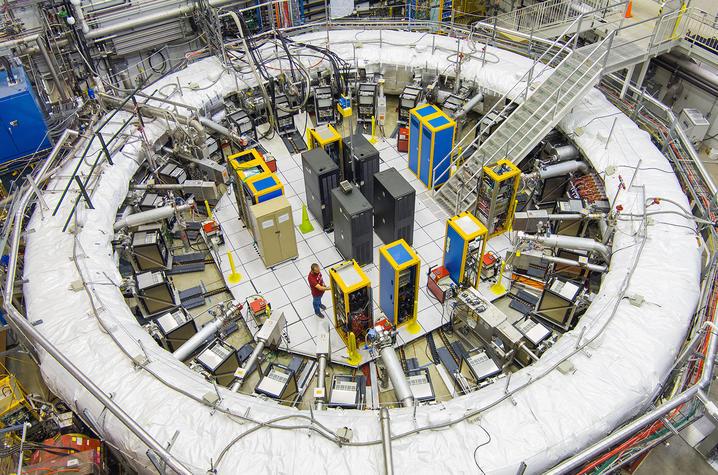By Jenny Wells-Hosley and Tracy Marc

A group of faculty, postdoctoral scholars and students from the University of Kentucky Department of Physics and Astronomy in the College of Arts and Sciences, supported by the National Science Foundation (NSF), are part of an international collaboration of scientists exploring uncharted territory in search of new physics.
The team has contributed to an important new development in the ongoing Muon g-2 experiment at the U.S. Department of Energy’s Fermi National Accelerator Laboratory (Fermilab). The results, announced today, reveal the most precise measurement to date involving particles called muons.
“This new measurement is a triumph for the entire collaboration,” said Renee Fatemi, UK professor of physics and co-principal investigator. “Such precision experiments are only possible when scientists from a wide range of fields pool their expertise to extract a single number from years of data taking. The UK team, composed of three PIs, two postdocs and four graduate students, is a microcosm of the larger collaboration, contributing on many levels to major components of the experiment.”
Muons are fundamental particles that are similar to electrons, but about 200 times as massive. Like electrons, muons have a tiny internal magnet that, in the presence of a magnetic field, precesses or wobbles like the axis of a spinning top. The precession speed in a given magnetic field depends on the muon magnetic moment, typically represented by the letter g. At the simplest level, Standard Model theory predicts that g should equal 2.
“The prediction that g is 2 ignores the quirk of quantum mechanics that particles can pop into and out of existence,” said Sean Foster, a UK postdoc who worked on the project. “These particles can ever-so-slightly alter how the muon interacts with the magnetic field, causing the value of g to deviate from 2. It’s this deviation — which we call 'g minus 2' — that our experiment measures with high precision.”
The new measurement announced today is a significant improvement from the experiment’s previous result in 2021. To make the measurement, researchers repeatedly sent a beam of muons into a 50-foot-diameter superconducting magnetic storage ring, where they circulated about 1,000 times at nearly the speed of light. Detectors lining the ring allowed scientists to determine how rapidly the muons were precessing. Physicists must also precisely measure the strength of the magnetic field to then determine the value of g-2.
UK students and postdocs contributed to the modeling and understanding of the muon beam, and made precision measurements of the magnetic field strength and the muon anomalous precession in the storage ring.
The collaboration describes their latest result in a paper submitted today to Physical Review Letters and anticipates releasing their final, most precise measurement of the muon magnetic moment in 2025 — setting up the ultimate showdown between Standard Model theory and experiment.
"Using the Standard Model of particle physics, theorists can make a prediction for the g-2 of the muon. If the prediction from the theory and the results from the experiment agree, then we say that theory is consistent with nature. If they don't, that's an indication that something is going on in nature that the theory does not account for,” said UK postdoc Alec Tewsley-Booth.
Until then, physicists have a new and improved measurement of muon g-2 that is a significant step toward its final physics goal.
The UK team is led by co-principal investigators Fatemi, Tim Gorringe and Brad Plaster — all professors in the Department of Physics and Astronomy — with support from UK graduate students Ritwika Chakraborty, Fang Han, Laura Kelton and Abel Lorente Campos, and postdoctoral scholars Sean Foster and Tewsley-Booth.
Read more here: https://news.fnal.gov/2023/08/muon-g-2-doubles-down-with-latest-measurement/.
Research reported in this publication was supported by the National Science Foundation under Award Numbers 2110479, 2110293 and 1714014 . The opinions, findings and conclusions or recommendations expressed are those of the author(s) and do not necessarily reflect the views of the National Science Foundation.
As the state’s flagship, land-grant institution, the University of Kentucky exists to advance the Commonwealth. We do that by preparing the next generation of leaders — placing students at the heart of everything we do — and transforming the lives of Kentuckians through education, research and creative work, service and health care. We pride ourselves on being a catalyst for breakthroughs and a force for healing, a place where ingenuity unfolds. It's all made possible by our people — visionaries, disruptors and pioneers — who make up 200 academic programs, a $476.5 million research and development enterprise and a world-class medical center, all on one campus.
In 2022, UK was ranked by Forbes as one of the “Best Employers for New Grads” and named a “Diversity Champion” by INSIGHT into Diversity, a testament to our commitment to advance Kentucky and create a community of belonging for everyone. While our mission looks different in many ways than it did in 1865, the vision of service to our Commonwealth and the world remains the same. We are the University for Kentucky.
